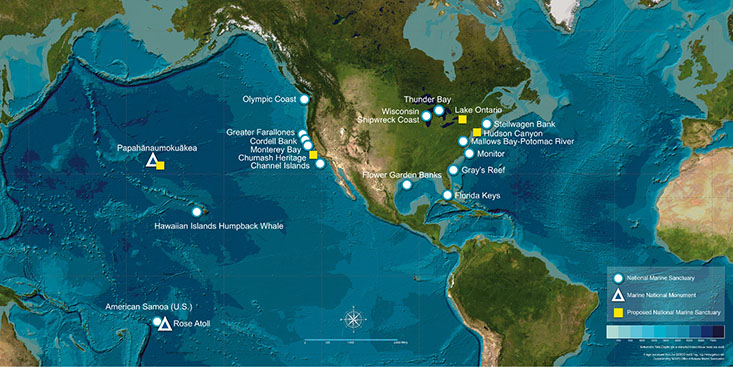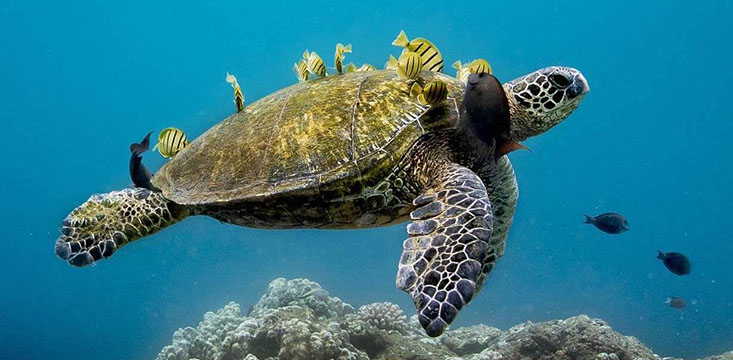This article has been adapted from an announcement by NOAA’s Climate Program Office.
A project led by researchers from the University of South Florida’s College of Marine Science (USF CMS) has been selected by NOAA’s Climate Program Office (CPO) to support the management of marine sanctuaries and national monuments in a changing climate.
The three-year project, “Climate Change Indicators Across the National Marine Sanctuaries System,” is one of seven competitively selected projects addressing marine sanctuary management totaling $3.7 million.
“Changes in climate change marine ecosystems. This has a direct impact on our own lives and the economy,” said Frank Muller-Karger, professor at USF CMS and the project’s lead principal investigator. “We typically don’t think about it, but marine life also plays a big role in climate by taking up and releasing nutrients and carbon. Our project will look at essential ocean variables that track these impacts in the National Marine Sanctuary System. The goal is to help answer the questions, ‘Have recent, accelerated changes in climate altered water conditions? And, if so, how are they changing?’”
The project’s co-principal investigators are Jennifer Dorton of the Southeast Coastal Ocean Observing System (SECOORA), Chris Simoniello of the Gulf of Mexico Coastal Ocean Observing System (GCOOS), Joshua Kilborn of USF CMS, and Rebecca Zarger of the Department of Anthropology at USF.

Marine sanctuaries and monuments are some of our nation’s underwater treasures. This image was reproduced from the General Bathymetric Chart of the Oceans (GEBCO) world map and customized by NOAA’s Office of National Marine Sanctuaries. Credit: NOAA
The seven marine sanctuary projects selected by CPO from around the nation will improve the understanding of climate variability and change on protected aquatic resources, and improve information about climate in sanctuary condition reports and for management planning. Projects will look at past climate variability and change in the sanctuaries system, improve datasets and analyses, apply models toward novel problems in the sanctuary system, and develop and deliver information products and resources to sanctuary managers.
“These projects are unique because they work hand-in-hand with people that use the sanctuaries,” said Muller-Karger, who was tapped by CPO to lead a new task force that brings all the projects together. “Their own experiences and new oceanographic data will help track how sanctuaries are changing. The information will be available in the same way for sanctuaries on the East Coast, Gulf of Mexico, West Coast, and as far away as the tropical Pacific.”
The marine sanctuary management projects are part of a larger CPO initiative to support new, innovative, and impactful projects that will improve our nation’s resilience at a critical time in the fight against the climate crisis. Sixty-three projects were selected for a total annual award of $15.2 million.
Over the next year, universities, other research institutions, and agency partners across the U.S., Puerto Rico, and the U.S. Virgin Islands, will conduct newly funded projects in partnership with NOAA programs, laboratories, and research centers.
“These grants will spur the knowledge and innovation needed to tackle the climate crisis which is a top priority for the Department of Commerce and NOAA,” said NOAA Administrator Rick Spinrad. “These new NOAA investments are essential to improve understanding of climate change, how to mitigate increasing impacts, and bolster community resilience. All of these substantive steps work together towards our goal of building a climate-ready nation.”
"CPO funds research to advance climate science and climate adaptation, as well as climate engagement, education, assessment, and integrated information systems," said Wayne Higgins, director of NOAA’s Climate Program Office. “These investments in climate science lead to credible and actionable information to enhance our nation’s resilience.”
The marine sanctuary projects were selected by CPO’s Climate Observations and Monitoring (COM) Program, in collaboration with the Modeling, Analysis, Prediction, and Projections (MAPP) Program and Climate and Societal Interactions (CSI) Division.
